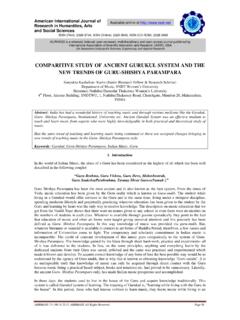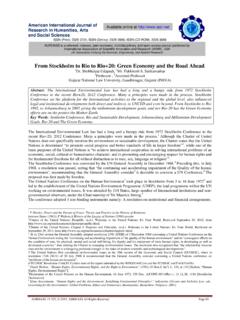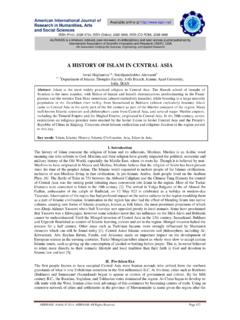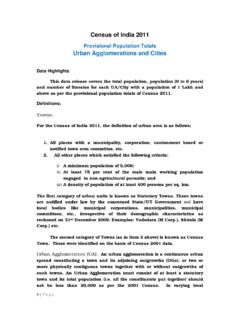Transcription of ISSN (Print): 2328-3734, ISSN (Online): 2328-3696, …
1 ISSN (Print): 2328-3734, ISSN (Online): 2328-3696, ISSN (CD-ROM): 2328-3688 American International Journal of Research in Humanities, Arts and Social Sciences AIJRHASS 14-203; 2014, AIJRHASS All Rights Reserved Page 239 Available online at AIJRHASS is a refereed, indexed, peer-reviewed, multidisciplinary and open access journal published by International Association of Scientific Innovation and Research (IASIR), USA (An Association Unifying the Sciences, Engineering, and Applied Research) Spatial Patterns of Skewed Child sex ratio in Rural Haryana Dr.
2 Sneh Sangwan Associate Professor, Department of Geography BPS Institute of Higher Learning Khanpur Kalan, Sonipat, Haryana, India Dr. Balwan Singh Assistant Professor, Department of Geography Govt. College Matak Majri, Karnal, Haryana, India Ms. Mahima Assistant Professor, Department of Geography Jat College, Rohtak, Haryana, India Dr. Randhir Singh Sangwan ProfessorDepartment of Geography University, Rohtak, Haryana, India I. Introduction A key and unusual demographic feature of India is an imbalance in the sex ratio . The ratio of females to males has been steadily declining for much of the last century.
3 The juvenile sex ratio the ratio of females to males aged 0 6 years (or the number of female children per 1000 male children in the age group of 0-6 years) has been declining even more sharply. While most countries around the world have a small imbalance in their juvenile sex ratios for biological reasons ( , there is a biological tendency for more male than female babies to be born to compensate for the slightly higher risk of mortality among newborn boys), the imbalance in India is acute, and is indicative of prenatal selection and excess female infant and child mortality.
4 Both in turn reflect a strong cultural preference for sons over daughters. Some estimates put the number of missing females ( , Abstract: The low and declining juvenile sex ratio in the country is a matter of grave policy concern, not only because it violates the human rights of unborn and infant girls but also because it deprives the country of the potential economic and social contribution of these missing women .As per provisional population figures of Census 2011, the developed states and union territories of India, particularly in its north-western part, such as Punjab, Haryana, Chandigarh and Delhi now have fewer than 900 girls per 1,000 boys.)
5 The child sex ratio in Haryana is 830 female children per 1000 male children, which is the lowest amongst all states of India, despite the fact that the state has experienced an increase of 10 points as against 820 in 2001. The present paper aims to study the trends and patterns of child sex ratio in rural Haryana and to examine the causes for deficiency of girl children in 0-6 age group resulting into imbalances in child sex ratio in the has witnessed a decline by 91 points in child sex ratio during the period from 1961 to 2001. The rate of decline has been even more conspicuous since 1981.
6 Between 1981 and 2001, child sex ratio in the state has gone down from 902 to 819, a decline by 83 points. However, an increase of 11 points has been noticed in CSR during the decade 2001 to 2011. Despite this increase, Haryana is at the lowest rung of ladder amongst all states of in its regional perspective, the child sex ratio in Haryana varies greatly from one part of the state to another. Out of the total of 74 tehsils, 33 tehsils of the state are attributed with child sex ratio above the state s average (830 female children per 1000 male children).
7 Amongst them, Punahana tehsil of Mewat district in southern Haryana has the highest child sex ratio of 917 female children per 1000 male children. It is followed by Ferozepur Jhirka (912) of the same district and Siwani tehsil (902) of Bhiwani district. At the other end of the scale, Kosli tehsil of southern Haryana has got the distinction of having lowest child sex ratio of 760 female children per 1000 male children not only in the state but also in the country as a whole. It is followed by the tehsils of Beri (768) in Jhajjar district, Mahendragarh (770) in the district of same name, Bahadurgarh (770) in Jhajjar district, and Naraingarh tehsil (770) of Ambala district in the north of Haryana.
8 It shows that practice of female foeticide is more prevalent in these tehsils because of easy access to sex-selective technology found in various parts of the state. Kew Words: Female Foeticide, Juvenile sex ratio , Missing Women, Sex-Selective Technology, Unborn Girls Sneh Sangwan et al., American International Journal of Research in Humanities, Arts and Social Sciences, 5(2), December 2013-February 2014, pp. 239-244 AIJRHASS 14-203; 2014, AIJRHASS All Rights Reserved Page 240 unborn girls) in India as high as 37 million (Sen, 2003).
9 The low and declining juvenile sex ratio in the country is a matter of grave policy concern, not only because it violates the human rights of unborn and infant girls but also because it deprives the country of the potential economic and social contribution of these missing women (Deolalikar et al., 2009). As per provisional population figures of Census 2011, the developed states and union territories of India, particularly in its north-western part, such as Punjab, Haryana, Chandigarh and Delhi now have fewer than 900 girls per 1,000 boys. Out of the total population (2,53,53,081) of Haryana, the population in 0-6 years age group is 32,97,724 and the sex ratio of this age group is 830 female children per 1000 male children, which is the lowest amongst all states of India, despite the fact that the state has experienced an increase of 10 points as against 820 in 2001.
10 II. Literature Cited On global scale, a number of studies have been documented by various scholars on patterns, trends, and determinants of declining child sex ratio in India (Chakraborty and Sinha, 2006; Deolalikar et al., 2009; Unisha, 2009, etc.). But on regional scale, especially in case of Haryana, only a few studies like Sangwan and Sangwan (2012) have focused their attention on declining child sex ratio and its aftereffects on the socio-cultural milieu of society. The present study has endeavoured, therefore, to examine the patterns, trends, and determinants of declining child sex ratio and its implications in the state.


















